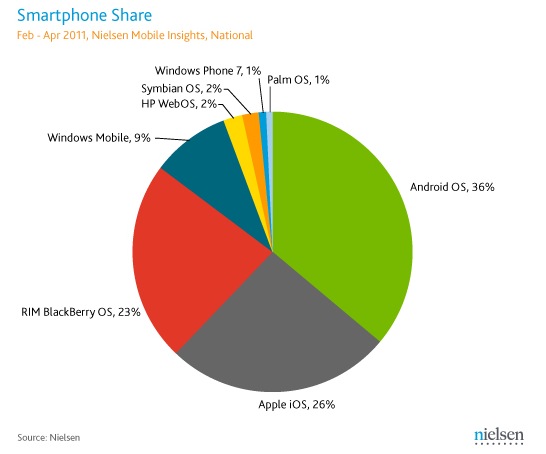
So, the most recent data on who’s winning between Apple and Google on the operating system front is brought to surface by recent Nielson research. To summarize – 37 percent of mobile consumers in the U.S. now have a smartphone. Google’s Android operating system (aOS) is proving to be the most popular. According to Nielsen’s April survey of mobile consumers, 36 percent of smartphone consumers now have an Android device, compared to 26 percent for Apple iOS smartphones (iPhones) and 23 percent for RIM Blackberry.

It used to be the case that even though Android OS device owners were gaining market share, it was shown that they weren’t as engaged in web activities and app hunting/usage but this recent research shows the lines between those iPhone users, who were always heavy data and app users, blurring a lot more. In fact, it’s nearly balanced out and the Nielson data suggests the consumption levels of data by aOS and iOS are showing signs of aligning with each other and even similarities in the type of data usage (i.e. app downloads, online gaming usage etc etc).What does this all mean? Well, for those of you thinking that mobile only means Apple iPhone, it’s time to think again. We’ve always looked at what to develop for by looking at the market the site and/or app is to serve and what makes sense for the product/service pitched against project budgets. But, in the age of the “web app”, this data definitely provides some strategic thinking shifts when talking about mobile plays and what to develop for. For us, it’s never ever just been about the iPhone. Having been in the mobile marketing space for over 10 years, development x-device / x-OS was always scope for any projects. But if you were in the court that thought mobile just meant iPhone, then gone are those days.For higher market penetration levels, you need to factor in aOS devices also and if you have existing mobile propositions, how does this new data affect your thinking. If you think it doesn’t – it should. First question, if you’ve developed a web-app or mobile site only designed for an iPhone, then how does your site look/feel/interact on Android devices. Hint: There are numerous different screen sizes on aOS devices versus one for the iPhone. How does your mobile proposition look on smart-phones other than the iPhone?






